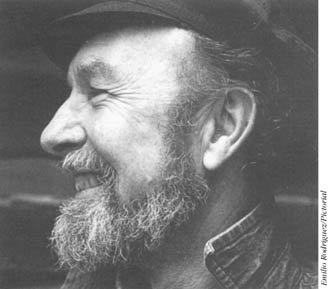
Pete Seeger, the Weaver’s leading light and a symbolic figure for the politically aware folk music movement.
The Weavers were one of the most influential folk groups of the 1950s and are remembered by many as the epitome of the protest era. Their songs form the link between old-style folk music and the folk/protest music that gave rock its intellectual and philosophical underpinning. The original Weavers were Pete Seeger, Lee Hays, Fred Hellerman, and Ronnie Gilbert. Seeger and Hays had formed the legendary Almanac Singers with Woody GUTHRIE and Millard Lampell in the early 1940s. The quartet included a baritone, a bass, an alto, and Seeger, who described himself as a “split-tenor.” Their formula was to create a harmonious sound that commanded listeners to join in, focusing on content rather than vocal effects.
Their first big break came in 1949, at the Village Vanguard in New York, when poet Carl Sandburg saw them and wrote: “When I hear America singing, the Weavers are there.” Soon the club was packed and the band had a contract with Decca. “Tzena, Tzena,” an Israeli soldier’s tune, was their first recording, and within weeks of release in April 1950 it was a hit. Next, DJs began playing the flip side, “Goodnight, Irene.” Though the Weavers did not include some of LEADBELLY’S more controversial lyrics, singing the music of a black ex-convict was an affirmation of the group’s political leanings. “Goodnight, Irene” stayed at No. 1 for 13 weeks and sold 2 million copies, while “Tzena” rose to No. 2. The group had ten more hits by early 1952, including “Kisses Sweeter Than Wine,” “So Long (It’s Been Good to Know You),” and the East African “Wimoweh.”
The Weavers’ early years were turbulent, as they battled with the rising tide of McCarthyism, and fear of anti-Communist violence prevented the progressives who made up their audience from gathering in public. Finally, in 1952, Seeger was blacklisted and ordered to appear before the House Un-American Activities Committee. This put a temporary halt to the group, but by this time their albums had all reached the charts and many songs had become standards.

Pete Seeger, the Weaver’s leading light and a symbolic figure for the politically aware folk music movement.
In 1955, the group formed again at the instigation of their manager, Harold Leventhal. New York’s Town Hall refused to accept a booking, and instead they performed at Carnegie Hall to tremendous acclaim. They continued to play together until 1964, although Seeger left the group in 1957 and was replaced by several different performers over the years. The group gathered for a final reunion concert at Carnegie Hall in 1980, with Lee Hays singing from a wheelchair. This concert was the centrepiece of a TV documentary on the Weavers, appropriately titled Wasn’t That a Time?
Stan Hieronymus
SEE ALSO: DYLAN, BOB; FOLK MUSIC; FOLK ROCK.
FURTHER READING
Harris, Craig. The New Folk Music (Crown Point, IN: White Cliffs Media Co., 1991);
Seeger, Pete, and Bob Reisner. Everybody Says Freedom: A History of the Civil Rights Movement in Songs and Pictures (New York: W. W. Norton, 1989).
SUGGESTED LISTENING
Best of the Weavers; Kisses Sweeter Than Wine; Wasn’t That a Time? The Weavers at Carnegie Hall.